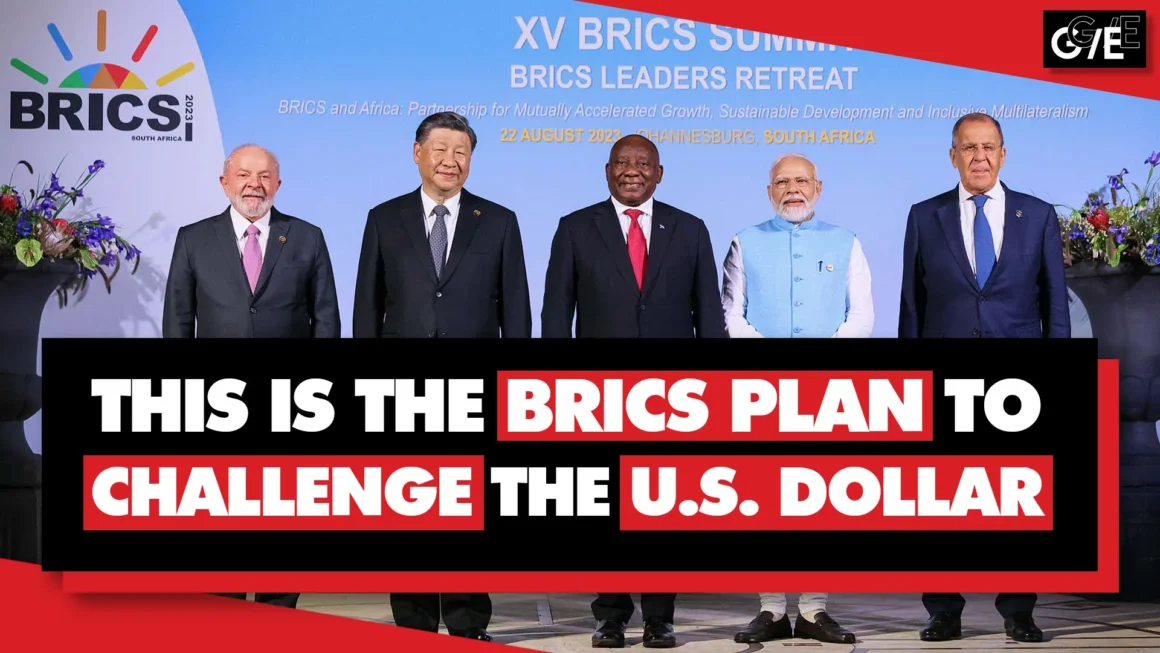
From internet buzz to real-world pilots, the BRICS currency is no longer just a dream—it’s the most talked-about challenge to decades of dollar supremacy.
Why Everyone Is Talking About the BRICS Currency
The BRICS currencies are dominating global headlines. In 2025, the bloc unveiled symbolic banknotes, launched the BRICS Pay digital settlement platform, and shifted nearly 90% of its intra-bloc trade into local currencies. These developments have elevated the idea from speculation to the forefront of newsrooms and boardrooms alike.
This matters because it questions the foundation of global trade: the dominance of the US dollar, which still backs around 80% of world transactions. If Brazil, Russia, India, China, and South Africa succeed in building a shared system, the world could see a fundamental shift in economic power, weakening Western leverage and accelerating the rise of a multipolar financial order.
What Exactly Is the BRICS Currency?
The BRICS currency is not yet a circulating coin or note. Instead, it is a proposed financial instrument to settle trade and investments among member nations. Ideas under discussion include:
- A basket-based unit like the IMF’s SDR, blending yuan, ruble, rupee, real, and rand.
- A digital settlement coin using blockchain to bypass SWIFT and dollar-based systems.
- A commodity-backed model, pegged partly to gold and oil, leveraging BRICS’ control of 40% of global oil production and 5,500 tonnes of gold reserves.
Recent events show momentum: BRICS Pay is live, symbolic notes have been unveiled, and intra-BRICS trade is now overwhelmingly conducted in national currencies. With the bloc representing 46% of global GDP (PPP) and 55% of the world’s population, these moves carry real weight.
Why Is the BRICS Currency Debate Happening Now?
The timing is shaped by global shocks and new capabilities:
- Russia Sanctions (2022): $300 billion in Russian reserves were frozen, proving the risks of dollar dependency.
- Digital Finance: Blockchain and central bank digital currencies now make alternative payment systems feasible.
- BRICS Expansion (2025): With new members like Indonesia joining, the bloc has expanded its economic influence.
- Trade Shift: Intra-BRICS trade is now overwhelmingly settled in local currencies, accelerating de-dollarization.
The Real Purpose Behind a BRICS Currency
The goal of a BRICS currency is not just monetary—it’s strategic.
- De-dollarization: Reduce reliance on the dollar’s near-monopoly in global trade.
- Resilience: Shield economies from sanctions and US monetary policy shocks.
- Multipolar Finance: Build a system reflecting BRICS’ rising share of global GDP and trade.
- Efficiency: Lower costs and reduce volatility in trade already exceeding $500 billion annually.
This is as much about symbolism and independence as it is about practical efficiency.
India’s Dilemma: Opportunity or Loss of Sovereignty?
India stands at the crossroads of ambition and caution. Its trade with BRICS partners is worth more than $160 billion annually, giving it clear benefits from smoother trade settlements. The Reserve Bank of India has been promoting rupee internationalization, signing agreements with over a dozen nations.
But India has also made its stance clear in 2025: a supranational BRICS currency is “not part of its financial agenda.” Instead, it prefers expanding trade in rupees, protecting its monetary sovereignty, and avoiding any system that could tilt toward Chinese dominance. With more than $120 billion in annual trade with the US and EU, India cannot afford to be seen as hostile to the West.
For New Delhi, the BRICS currency is an attractive idea but one fraught with risks to sovereignty and stability.
A Timeline of the BRICS Currency Journey
- 2001–2009: From Acronym to Alliance
BRIC coined in 2001; first official summit in 2009 during the global financial crisis. - 2010–2014: Expansion and Institutions
South Africa joins in 2010. BRICS launches the $100B New Development Bank and $100B Contingent Reserve Arrangement. - 2015–2019: Early De-Dollarization Moves
Local currency swaps introduced; Russia and China push hardest, India and Brazil remain cautious. - 2020–2022: Pandemic & Sanctions
COVID-19 exposed dollar dependence; Russia sanctions in 2022 revived the push for alternatives. - 2023–2024: Digital Steps
BRICS Pay system developed; discussions of digital settlement intensified. - 2025: Peak Momentum
- BRICS Pay officially launched with CBDC integration.
- Symbolic banknotes unveiled to showcase ambition.
- Nearly 90% of intra-BRICS trade conducted in local currencies.
- Brazil’s NDB commits to financing in local currencies but avoids a single coin.
- Brazil’s central bank admits BRICS lacks reserve depth to rival the dollar.
- US threatens tariffs of up to 60% on BRICS nations; bloc leaders push back.
- BRICS Pay officially launched with CBDC integration.
The Road Ahead: Can BRICS Really Launch Its Own Currency?
The outlook depends on unity and political will. In the best case, BRICS Pay evolves into a fully fledged digital settlement unit within the decade, gradually eroding dollar dominance. More realistically, local currency trade and payment systems will expand, but a unified coin will remain distant. In the worst case, political rifts—particularly India–China tensions and Brazil’s Western ties—combined with external pressure could stall progress and leave the currency symbolic.
Hype, Hope, or Historic Change?
The BRICS currency has shifted from speculation to real-world steps. Digital platforms are active, symbolic notes have been unveiled, and trade is already moving away from the dollar. Yet a true reserve currency is still far off, blocked by fragmented policies, rivalries, and shallow capital markets.
Still, one thing is clear: the dollar’s supremacy is no longer beyond question. Even if BRICS never launches a single coin, the bloc has already forced the world to imagine a multipolar financial order. And that shift—from theory to reality—is historic in itself.
FOR MORE BLOGS – beyondthepunchlines.com

 Add to favorites
Add to favorites








